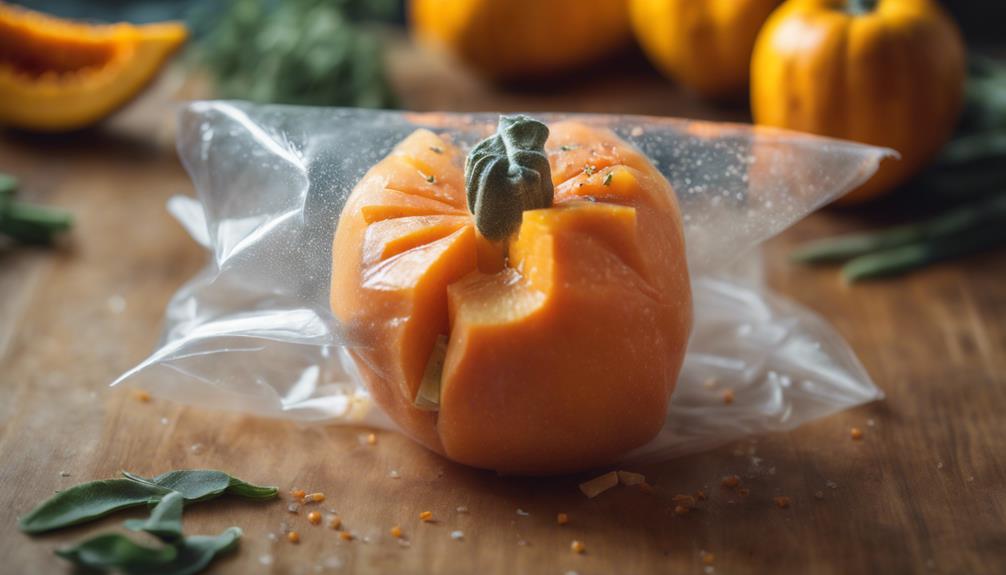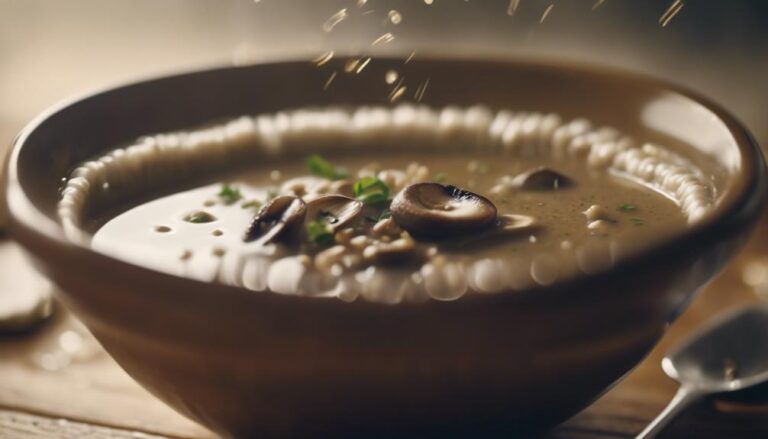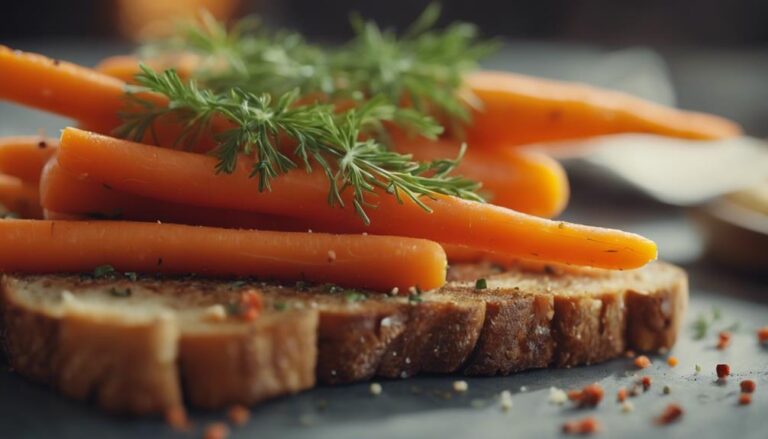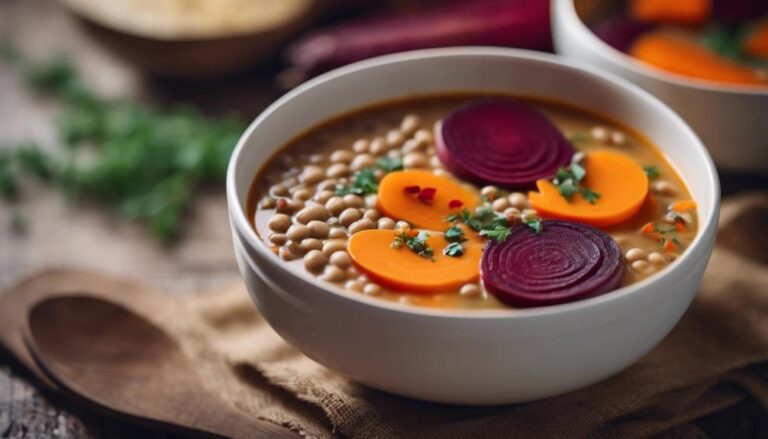Sous Vide Squash and Apple Soup With Sage
Indulge in the velvety richness of a sophisticated blend of squash, apples, and aromatic sage with our sous vide squash and apple soup with sage recipe. This culinary delight elevates traditional flavors with a modern twist in your own kitchen. The butternut squash brings a creamy texture, apples add natural sweetness, and sage infuses earthy aromatic notes. Cooking at 185°F for 1 hour guarantees maximum flavor development without mushy textures. Discover the perfect balance of flavors and techniques in this nutrient-rich fall meal. Master the art of sous vide for a consistent and flavorful outcome. Embrace the culinary journey ahead.
What You Will Learn Here
- Sous vide cooking at 185°F (85°C) for 1 hour ensures rich, velvety soup texture.
- Butternut squash provides creamy base, apples add sweet-tart notes, and sage enhances flavor.
- Maintaining precise temperature extracts full flavors for a rich, aromatic soup.
- Sage infusion at 185°F (85°C) maximizes flavor depth and control in the soup.
- Versatile as a starter or main course, offering nutrient-rich fall meal options.
Soup's Origin Story
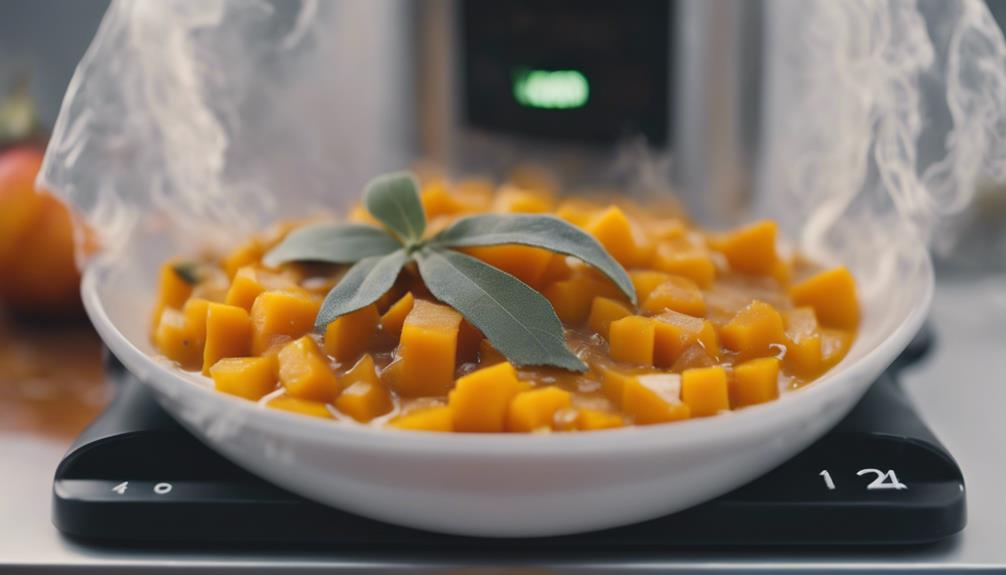
Picture yourself transported back to the early days of American colonial times, where squash and apple soup simmered in hearths, filling homes with warmth and comfort.
The blend of sweet apples and savory squash in this soup not only tantalizes your taste buds but also speaks to a time when ingredients were scarce, and creativity was abundant.
As you savor each spoonful, you can't help but appreciate the rich history and cultural significance behind this humble yet flavorful dish.
Soups Historical Roots
Dating back to ancient civilizations like the Egyptians, Greeks, and Romans, soups have a rich historical legacy that spans thousands of years. Soups Historical Roots are deeply intertwined with the evolution of culinary practices, offering comforting, nutritious, and versatile dishes enjoyed worldwide. From humble beginnings of boiling ingredients in water to create nourishing meals, soups have become a symbol of culinary creativity, reflecting diverse cultures and ingredients. Whether it's the Chinese hot and sour soup, Italian minestrone, or Mexican pozole, each culture's unique traditions contribute to the rich tapestry of soup varieties. Embracing a wide range of ingredients, soups continue to be cherished for their ability to bring warmth and nourishment to the table.
| Cultural Influence | Signature Ingredients | Notable Attributes |
|---|---|---|
| Egyptians | Barley, Onions | Nutrient-Rich |
| Greeks | Olive Oil, Herbs | Medicinal Properties |
| Romans | Garum (Fermented Fish Sauce), Vegetables | Culinary Innovation |
Influences on Flavors
In the intricate tapestry of flavors that compose the sous vide squash and apple soup, the harmonious blend of seasonal ingredients takes center stage.
The sous vide butternut squash, sweet apples, and fragrant sage come together to create a symphony of tastes that evoke the essence of fall.
Through the precise technique of sous vide cooking at 185°F (85°C) for 1 hour, the soup achieves a depth of flavor and a luxurious velvety texture.
The butternut squash lends a creamy richness, while the apples contribute a natural sweetness that balances perfectly with the earthy notes of sage.
This combination of fall ingredients not only delights the taste buds but also warms the soul, making it a comforting and satisfying choice for a cozy autumn meal.
Cultural Soup Traditions
Cultural soup traditions worldwide reveal a rich tapestry of flavors, techniques, and stories that date back to ancient civilizations. Soups have been a fundamental part of diverse cultures, from the hearty French onion soup to the spicy Mexican pozole. Each culture's soup heritage reflects its unique ingredients, cooking methods, and historical influences. For example, in Asian cuisine, soups like miso and tom yum are celebrated for their bold flavors and medicinal properties. In contrast, Eastern European traditions often feature hearty broths like borscht, served with homemade bread. Whether it's a comforting apple soup recipe or a velvety squash soup prepared using the sous vide method, the use of aromatic spices and fresh ingredients underscores the importance of soup in cultural culinary practices.
| Cultural Soup Tradition | Unique Aspects |
|---|---|
| French Bouillabaisse | Seafood-based, rich in saffron |
| Italian Minestrone | Vegetarian, loaded with seasonal vegetables |
| Chinese Hot and Sour Soup | Tangy and spicy, balancing yin and yang |
| Mexican Pozole | Hominy corn, seasoned with chili peppers |
Key Soup Components
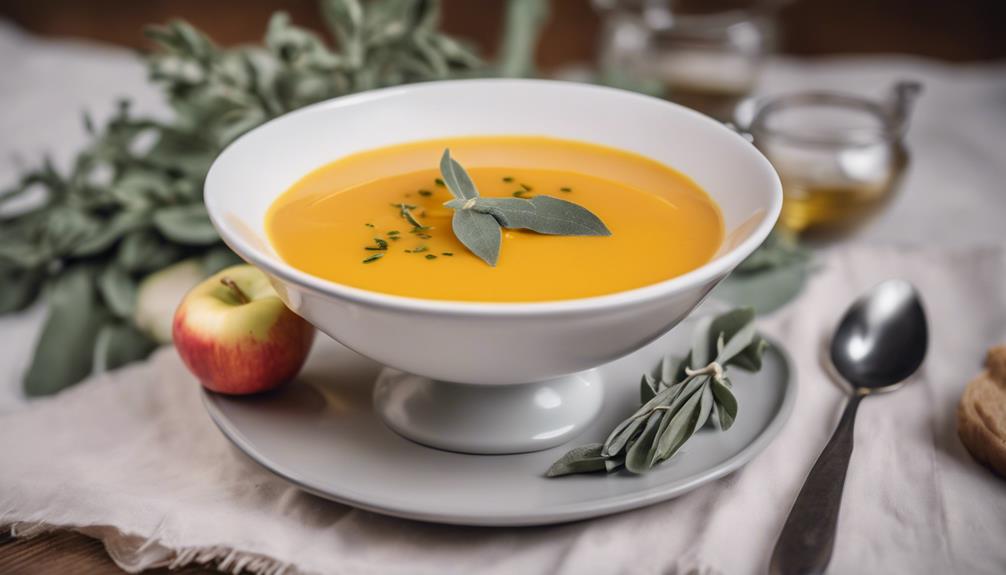
The essence of this sous vide squash and apple soup lies in the harmonious blend of the key components – butternut squash, apple, and sage – working together to create a flavorful and comforting culinary experience. Here's why these components are essential:
- Butternut Squash: The butternut squash provides a creamy texture and a slightly sweet flavor that forms the base of the soup, giving it a velvety richness that's both satisfying and nourishing.
- Apple: The addition of apple adds a hint of natural sweetness and a subtle tartness that balances the richness of the squash, creating a harmonious flavor profile that's both comforting and revitalizing.
- Sage: The earthy and aromatic notes of sage elevate the soup, adding depth and complexity to the overall taste experience. Its herbaceous quality complements the sweetness of the squash and apple, creating a well-rounded and flavorful dish.
Trending Soup Variations
You're about to uncover the newest trends in soup variations that are shaking up the culinary scene.
Get ready to experience the unique sous vide method that elevates the flavors of classic ingredients like butternut squash and apple.
The velvety infusion of sage adds a sophisticated touch, making this soup a must-try for those seeking a gourmet twist on traditional favorites.
Unique Sous Vide Method
For a distinctive take on traditional soup-making methods, consider exploring the innovative sous vide technique for crafting a flavorful and nutrient-rich squash and apple soup with sage.
When utilizing the sous vide method, you'll experience enhanced flavors due to the ingredients cooking in a vacuum-sealed bag. The precise temperatures employed guarantee that every spoonful of soup is bursting with rich and well-balanced tastes.
Additionally, this fragrant soup benefits from the convenience of sous vide cooking, allowing you to achieve a delicious meal without constant monitoring.
Embrace the sous vide method for a hands-off approach that promises a perfectly cooked and aromatic soup, ideal for serving up a comforting and nutritious dish to your guests.
Sous Vide Butternut Squash Blend
Transitioning from exploring the innovative sous vide method, immerse yourself in the popular soup variation of Sous Vide Butternut Squash Blend, a cozy seasonal dish filled with delicious ingredients cooked to perfection.
This comforting soup combines the sweetness of butternut squash with the tartness of apple, creating a harmonious blend of flavors. The aroma of onions, garlic, and herbs permeates each spoonful, bringing warmth and comfort with every bite.
The sous vide technique guarantees that the ingredients are flawlessly cooked at a precise temperature, allowing the natural flavors to shine through. When blended to a velvety smooth texture and adjusted with stock or cream, this soup becomes a luxurious indulgence that will please your taste buds.
Velvety Sage Infusion
Infusing the velvety Sage into your squash and apple soup elevates its flavors to a gourmet level, adding a fragrant, earthy note that perfectly complements the sweetness of the ingredients. Here's how the Sage infusion enhances your comforting meal:
- Visual Appeal: As the Sage leaves gently infuse, they release their essence, creating a beautiful swirl of green in the golden soup.
- Aromatic Ambiance: The aroma of Sage fills the kitchen, welcoming you with its cozy, fall vibes, making you anticipate each spoonful.
- Complex Flavor Profile: The velvety Sage infusion not only adds depth but also balances the sweetness of the squash and apple, creating a harmonious and satisfying blend for your taste buds.
Sous Vide Temperature Recommendation
To guarantee the ideal infusion of sage flavors and achieve a consistent texture in your butternut squash and apple soup, maintaining a precise sous vide temperature of 185°F (85°C) is essential. Cooking at this temperature allows the ingredients to cook evenly, resulting in a deliciously flavored dish.
Follow the recommended temperature guideline for a flawlessly cooked and flavorful soup.
Ideal Sous Vide Temperature
For ideal results when preparing butternut squash and apple soup using the sous vide method, it's essential to set the temperature precisely at 185°F (85°C) for a duration of 1 hour. This ideal temperature guarantees consistent cooking and maximum flavor development.
Cooking at this specific temperature allows the flavors of the butternut squash and apple to blend together, resulting in a rich and delicious soup. Maintaining this precise temperature throughout the cooking process is vital to avoid undercooked ingredients or mushy textures.
Sage Infusion Technique
Enhance the depth of flavor in your butternut squash and apple soup by accurately setting the sous vide temperature to 185°F (85°C) for infusing sage.
Sage infusion through sous vide is crucial to achieving a controlled flavor profile, allowing the earthy and aromatic notes of the sage to harmonize with the main ingredients.
By employing the sous vide technique, you guarantee a precise and consistent release of sage's essential oils, resulting in a well-balanced infusion that doesn't overpower the delicate flavors of the soup.
The longer infusion time permitted by sous vide maximizes the depth of sage flavor in the butternut squash and apple soup, creating a rich and flavorful experience for your diners.
Flavor Development Tips
To achieve ideal flavor development in your sous vide butternut squash and apple soup, maintaining a precise temperature of 185°F (85°C) is crucial. Cooking at this specific temperature for 1 hour guarantees that the ingredients, including the squash, apple, and sage, are cooked uniformly, allowing them to release their full flavors.
This temperature is carefully selected to strike a balance: too low, and the ingredients may remain underdeveloped; too high, and you risk losing the delicate nuances of the flavors. By following the 185°F (85°C) recommendation, you ensure a soup rich in aroma and taste, extracting the maximum potential from the herbs and spices.
Serve your guests a perfectly cooked sous vide squash and apple soup with sage, bursting with flavor.
Final Thoughts
In reflecting on the rich and nuanced flavors of this sous vide squash and apple soup with sage, one cannot help but appreciate the depth of culinary experience it offers. The combination of tender sous vide-cooked squash and sweet apples creates a velvety texture that is both comforting and satisfying. The infusion of sage adds a layer of earthiness, elevating the soup to a new level of sophistication. This dish not only tantalizes the taste buds but also nourishes the body with its nutrient-rich ingredients.
Below is a table summarizing key points about this delightful sous vide butternut squash and apple soup with sage:
| Key Points | Description |
|---|---|
| Flavor Profile | Rich and nuanced flavors combining tender squash, sweet apples, and fragrant sage. |
| Versatility | Can be enjoyed as a starter or a main course, offering a healthy and comforting meal option. |
| Cooking Technique | Sous vide cooking offers precise temperature control for consistent and delicious results. |
| Nutrient Content | Packed with nutrients, it's a perfect choice for a fall meal that is both delicious and wholesome. |
| Garnish | Fresh sage garnish adds an aromatic and earthy touch, enhancing the overall flavor profile. |
Frequently Asked Questions
Why Is My Squash Soup Bitter?
If your squash soup tastes bitter, consider adjusting cooking times, choosing ripe squash, and balancing flavors. Roasting technique can enhance sweetness. Guarantee proper seasoning balance, pair vegetables well, and aim for a creamy consistency.
What Is the Point of Sous Vide?
Sous vide benefits you by offering precise cooking, flavor infusion, time saving, consistent results, and tender texture. It elevates your dishes by retaining nutrients and enhancing flavors, making each bite delicious and satisfying.
Conclusion
Indulge in the velvety texture and rich flavors of this sous vide squash and apple soup with sage. The precise cooking method guarantees that every ingredient is flawlessly cooked and infused with the essence of sage.
This trendy variation on a classic soup is certain to impress your taste buds with its depth of flavor and comforting warmth. Elevate your soup game with this delicious and innovative recipe.
